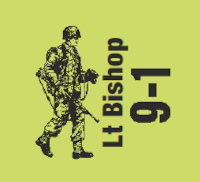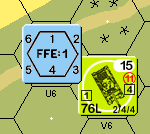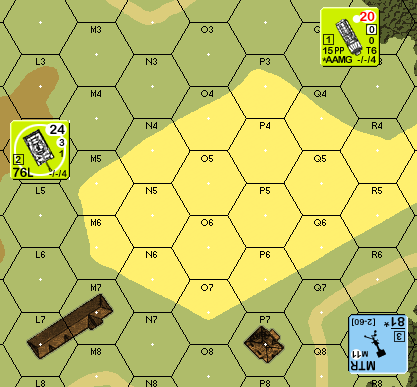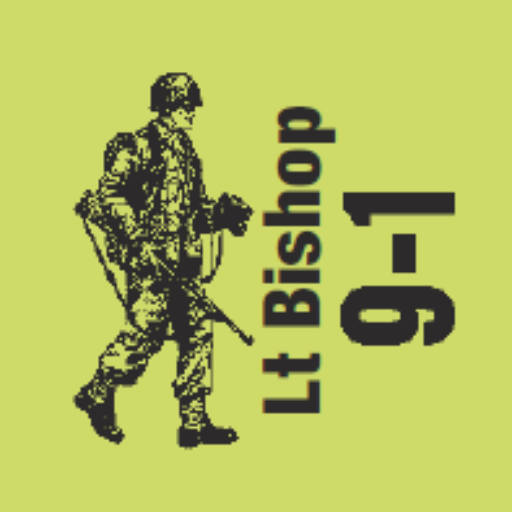
In this article I will examine the effects of Indirect Fire against AFVs. A reader suggested this topic to me because he struggles with the mechanics of these attacks. Personally, I think these attacks are not well understood and because of this, some players ignore these attacks to their detriment. Let’s have a look.
First, I will presume the reader understands the mechanics of obtaining a hit. I will not cover the To Hit process or DRMs associated with it. I will deal exclusively with how to resolve the attack. For this, we will need to examine C1.55 and D5.311.
So what is “Indirect Fire?” The index defines Indirect Fire as mortar/OBA and refers us to C.1. Sadly, C.1 creates confusion by saying onboard ordnance are limited to the Direct Fire To Hit process. Don’t let this fool you. Onboard mortars are using Indirect Fire even though they use the Direct Fire To Hit process. The “Indirect Fire To Hit” process is OBA (radio contact, card draws, AR, SR, FFE). OBA and mortars use Indirect Fire, even when the mortar is onboard.
OBA Versus AFVs

Suppose you have managed to properly call in and convert your 100mm OBA in a hex adjacent to an AFV. Now we must resolve it, but how? Per C1.55, we attack this AFV on the IFT using the column appropriate for our OBA. In this case, the 20 column. We roll and compare the IFT result with the AFV Destruction Table, looking at the Indirect Fire column to determine the fate of the AFV. C1.55 lists a few applicable DRMs, -1 if all Armor Factors (AF) are ≤ 4 , -1 if Open Topped, and +1 if all AF are greater ≥ 8. Looking at the example in Figure 1 we see there are no applicable DRM.
Looking at the AFV Destruction Table, if the Final DR is a KIA, the vehicle is destroyed. If the Final DR is ≤ half of the K/# for that column–corresponding to a 4 on the 20 column–the AFV is a Burning Wreck. This means a 2 is not only a wreck, but a burning wreck. If the Final DR equals, or is one greater than, the K/#, the vehicle is Shocked or Immobilized. On the 20 column, that is a Final 4 or 5. The OBA effects DR also determines the Hit Location (C3.9). Also note, with Indirect Fire, the Shock is automatic, even when one greater than the K/#. Any other result is NA versus the AFV but may still harm vulnerable PRC collaterally.
To summarize, a Final DR 2 is a wreck (KIA) and a burning wreck ( ≤ 4, the K/# row). A Final DR ≤ 3 is a wreck. A Final DR ≤ 5 results in Shock/Immobilization. Any other result is NA against the AFV but could affect vulnerable PRC collaterally.
Mortars Versus AFVs

Once you have scored a hit, you resolve mortar attacks versus an AFV in the same fashion. Establish the IFT column the mortar attacks on, roll on the IFT, apply any C1.55 modifiers to get the Final DR. Finally compare the IFT result obtained with the AFV Destruction Table.
Assume the mortar has hit the Hellcat on the hill. An 81mm mortar attacks on the 8 column. This AFV is not only open topped, but all of its AF are less than 4 yielding a -2 DRM from C1.55. Cross referencing the 8 column with the Destruction Table, an Original DR ≤ 3 burns the AFV, Original DR ≤ 4 wrecks the AFV, and an Original DR ≤ 6 Shocks/Immobilizes the AFV. Just as with OBA attacks, the IFT DR establishes the Hit Location against the Hellcat.1 The TH DR determines the Hit Location (C3.9). If the AFV is unaffected, the vulnerable crew is still attacked on the 8 column with a +2 CE DRM. 2 As such, an Original DR of 7 results in a PTC against the vulnerable PRC (7 +2 CE DRM). An Original DR ≥ 8 is NA against both vehicle and crew.
Airbursts
Let’s look at a special case. The M3 halftrack is bypassing the woods. Assuming you hit, all the C1.55 DRMs remain the same (-1 all AF ≤ 4, -1 OT). However, the attack itself is completely different. Notice D5.311 says “If an OT AFV’s crew would receive a CE DRM reduced by Elevation-Effects/Air-Bursts to < its normal CE DRM, that AFV is instead treated as unarmored …” In this instance, the attack against the ht is conducted on the star (★) vehicle line (A7.308). Looking at the 8 column, a Final DR = 7 Immobilizes the ht, ≤ 6 wrecks the ht, and ≤ 3 turns the ht into a burning wreck.
Even though the ht is unaffected by a Final DR ≥ 8, the PRC are still vulnerable to the attack. On an Original DR 8, the PRC would receive a +2 CE DRM and a -1 Airburst TEM for a total DRM of +1 for a Final DR = 9. Vulnerable PRC are subject to a PTC for a Final DR 8 on the 8 column.
Conclusion
That’s all there is to it. You can even knock out a big, hulking Panther with Indirect Fire. An 81mm mortar attacking on the 8 column, Shocks/Immobilizes/Wrecks/Burns a Panther on a Final DR ≤ 4 (~ 17% chance). Throw in a ROF of 3 and large target modifier and suddenly that Panther isn’t so scary anymore. Even the lowly 50mm mortar can achieve a result on a Final DR ≤ 3. Certainly not stellar odds but at least it’s a chance when no other tools are available. With a good ROF tear, it might be a lot of chances. Early in the war when all AFs are ≤ 4, the 50mm achieves a result on a Final DR ≤ 4, every bit as good as the 81mm mortar.
As always, I hope you find this article useful. If you spot an error or have a question, don’t hesitate to reach out via the contact form at the top right. Until next time. — jim
Version 1.31


I have updated this article based on a Q&A I received from Perry. I have struck through the original text affected by the Q&A. — jim
Hello Bishop,
how to resolve an onboard mortar attack against this specific vehicle, SdKfz8 Flak 88 (BFP – PIF module), classified however armored vehicle that it is hit in the top through one side of the turret, which makes the only crew as if they were on an unarmored vehicle and with a result on the destruction table AFV – Indirect Fire of HE>1?
Reading the vehicle note, the AFV is “armored”, even through the side rear. So you attack it normally via C1.55. If it takes airbursts, you attack it via D5.311. If the AFV isn’t destroyed in the attack, attack the PRC via a Collateral Attack (ATT would use a GCA, all others would use a SCA). That’s how I would play it. — jim
Thanks Bishop and congratulations on your articles.
I’m still not entirely sure what Hit Location C3.9 has to do with the process? Maybe if the AFV was hull down, or if the effects would determine shock or immobilization, I can see the importance knowing the hit location.
What else am I missing with hit location and indirect ordnance?
Thanks Jim!
The attack can cause Shock or Immobilization.